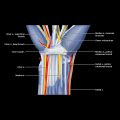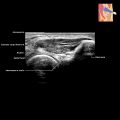Radial Nerve
GROSS ANATOMY
Arm
Forearm
 Superficial branch of radial nerve (purely sensory)
Superficial branch of radial nerve (purely sensory)
 Deep branch of radial nerve (purely motor)
Deep branch of radial nerve (purely motor)
 Fibrous band of radial head, which is continuous with extensor carpi radialis brevis (ECRBr) and superficial head of supinator muscle
Fibrous band of radial head, which is continuous with extensor carpi radialis brevis (ECRBr) and superficial head of supinator muscle
 Radial recurrent vessels (leash of Henry) at level of radial head
Radial recurrent vessels (leash of Henry) at level of radial head
 Tendinous margin of ECRBr
Tendinous margin of ECRBr
 Aponeurotic proximal margin of supinator (arcade of Fröhse) = most common site of compression
Aponeurotic proximal margin of supinator (arcade of Fröhse) = most common site of compression
 Distal margin of supinator muscle
Distal margin of supinator muscle
Radial Nerve















